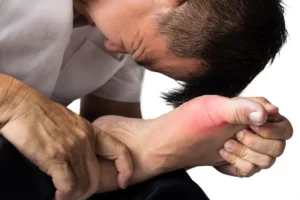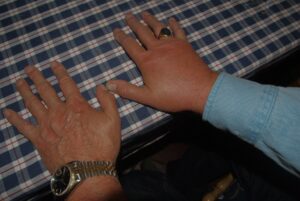Complex Regional Pain Syndrome (CRPS), also known as Reflex Sympathetic Dystrophy (RSD), is a chronic pain condition that affects the limbs, usually an arm or leg, but it can also occur in the trunk, face, and other body parts. CRPS is characterized by severe pain, swelling, and changes in the skin color and temperature of the affected limb. In some cases, CRPS can also cause muscle weakness and joint stiffness.
The exact cause of CRPS is not known, but it is thought to be caused by a dysfunction in the nervous system, which leads to the overproduction of pain signals. CRPS is often triggered by an injury, surgery, or other medical procedures, but it can also develop spontaneously.
Symptoms of CRPS
Severe pain: The most common symptom of CRPS is intense pain that is often described as burning or aching. The pain is often out of proportion to the original injury and can persist for months or even years.
Changes in skin color and temperature: The affected limb may appear red, purple, or blue and may feel warm to the touch. The skin may also become thin, shiny, and sensitive to the touch.
Swelling: Swelling of the affected limb is common and can cause the limb to appear larger than the unaffected limb.
Changes in nail and hair growth: The nails may become thick and brittle, and hair growth may be affected.
Muscle weakness and joint stiffness: The affected limb may become weak, and movement may become difficult. The joint may also become stiff and difficult to move.
Allodynia: This is a condition where the affected limb becomes painful in response to stimuli that would not normally cause pain, such as a light touch or a gentle breeze.
Hyperalgesia: This is an increased sensitivity to pain, where even a mild stimulus causes severe pain.
Treatment for CRPS
Treatment for CRPS is aimed at reducing pain and improving function. The following are some of the treatments that are commonly used for CRPS:
Medications: Nonsteroidal anti-inflammatory drugs (NSAIDs), such as ibuprofen, can help relieve pain and swelling. Antidepressants, such as amitriptyline, can also help to reduce pain. In severe cases, opioids may be prescribed, but they are often used only as a last resort due to the risk of dependence and addiction.
Physical therapy: Physical therapy can help to improve strength and mobility in the affected limb. This may include exercises to increase flexibility, strength, and range of motion.
Occupational therapy: Occupational therapy can help to improve function and reduce pain. This may include the use of splints, braces, or other assistive devices.
Psychological therapy: Psychological therapy, such as cognitive behavioral therapy (CBT), can help to reduce pain by changing negative thought patterns and behaviors.
Interventional treatments: Interventional treatments, such as nerve blocks and spinal cord stimulation, can help to relieve pain.
Surgery: In severe cases, surgery may be necessary to relieve pain. This may include the removal of a damaged nerve, the implantation of a spinal cord stimulator, or the release of a nerve entrapment.
Alternative therapies: Alternative therapies, such as acupuncture and massage, can help to reduce pain and improve function.
In conclusion, CRPS is a chronic pain condition that affects the limbs and is characterized by severe pain, swelling.

 Home
Home Health
Health Diet & Nutrition
Diet & Nutrition Living Well
Living Well More
More












